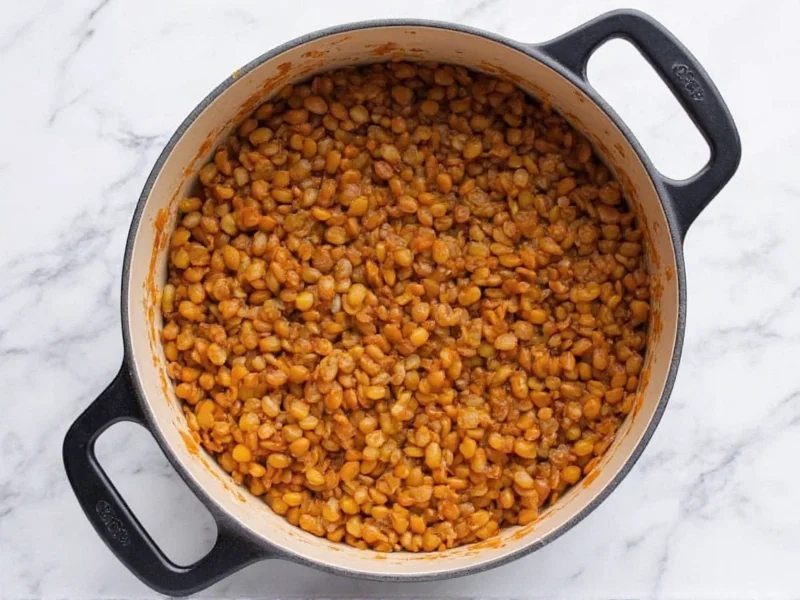Mastering lentil preparation transforms this humble legume into a versatile, protein-packed ingredient for countless dishes. Unlike other pulses, lentils don't require pre-soaking, making them one of the most convenient plant-based protein sources. Understanding the subtle differences between varieties prevents common cooking mistakes that lead to either mushy or undercooked results.
Understanding Lentil Varieties and Their Cooking Needs
Lentils come in several varieties, each with unique cooking properties. Selecting the right method for your specific lentil type ensures optimal texture and flavor absorption. The cooking time difference between brown and red lentils can mean the difference between a firm salad ingredient and a smooth dal.
| Lentil Type | Texture After Cooking | Water-to-Lentil Ratio | Cooking Time |
|---|---|---|---|
| Brown/Green | Firm, holds shape | 2.5:1 | 20-25 minutes |
| French (Puy) | Firm with peppery flavor | 3:1 | 25-30 minutes |
| Red/Yellow | Soft, breaks down easily | 2:1 | 15-20 minutes |
| Black (Beluga) | Firm, caviar-like | 3:1 | 25-30 minutes |
Essential Preparation Steps
Proper preparation prevents unpleasant surprises in your cooked lentils. Always sort through dry lentils to remove any small stones or debris that may have made it through processing. Though modern packaging has reduced this issue, it remains a crucial safety step, especially with bulk purchases.
Rinse lentils thoroughly in a fine-mesh strainer under cold running water. Swirl them with your fingers to dislodge any dust. This simple step removes surface starch that can cause foaming during cooking and eliminates potential bitterness. Never skip rinsing, even if package instructions suggest it's unnecessary.
Perfect Stovetop Cooking Method
The traditional stovetop method delivers reliable results when followed precisely. After rinsing, combine lentils with cold water or broth in a heavy-bottomed pot. Starting with cold liquid ensures even cooking throughout the lentils. Bring the mixture to a gentle boil over medium-high heat, then immediately reduce to low.
Cover the pot with a slightly ajar lid to allow some steam to escape, preventing boil-overs while maintaining consistent temperature. Simmer until tender, checking periodically after the minimum cooking time. The ideal texture varies by application: salads need firmer lentils, while soups benefit from softer ones.
Advanced Cooking Techniques
For restaurant-quality results, timing acid and salt additions correctly makes a significant difference. Add acidic ingredients like tomatoes or vinegar only after lentils have softened, as acid prevents softening and can lead to tough lentils. Similarly, delay salt addition until the final 5-10 minutes of cooking.
When making lentil soup or dal, sauté aromatics like onions, garlic, and spices in oil before adding lentils and liquid. This technique, called tempering, releases essential oils from spices and creates deeper flavor complexity. For creamier results without dairy, blend a portion of cooked lentils and stir back into the pot.
Alternative Cooking Methods
Pressure cookers dramatically reduce cooking time while maintaining texture. For most lentils, use a 1:1.5 lentil-to-liquid ratio and cook at high pressure for 8-12 minutes, followed by a 10-minute natural release. This method works particularly well for brown and green lentils when you need them quickly for salads or sides.
Slow cookers produce exceptionally tender lentils ideal for soups and stews. Use a 1:3 lentil-to-liquid ratio and cook on low for 6-8 hours. The extended cooking time allows flavors to meld beautifully, though red lentils may become too soft for some applications.
Troubleshooting Common Lentil Problems
Hard lentils after cooking usually indicate old lentils or insufficient cooking time. Check expiration dates and consider increasing cooking time by 5-10 minutes. If lentils become mushy, you've likely used too much water or overcooked them—reduce liquid by 0.5 cups next time.
Excessive foaming during cooking comes from surface starch. Skim foam with a spoon during the first few minutes of boiling, or add a tablespoon of oil to the cooking water. For consistently perfect results, always measure water precisely and set a timer—lentils can go from perfect to overcooked in minutes.
Storing and Using Cooked Lentils
Cooked lentils keep well in airtight containers in the refrigerator for up to 5 days or frozen for 3 months. Store them in their cooking liquid to maintain moisture. When reheating, add a splash of water to restore moisture.
Cold cooked lentils work beautifully in salads, while warm lentils pair well with roasted vegetables or as a protein boost in grain bowls. For meal prep efficiency, cook a large batch at the beginning of the week and portion for various meals. The best way to cook lentils for meal prep involves slightly undercooking them to account for texture changes during storage.











 浙公网安备
33010002000092号
浙公网安备
33010002000092号 浙B2-20120091-4
浙B2-20120091-4